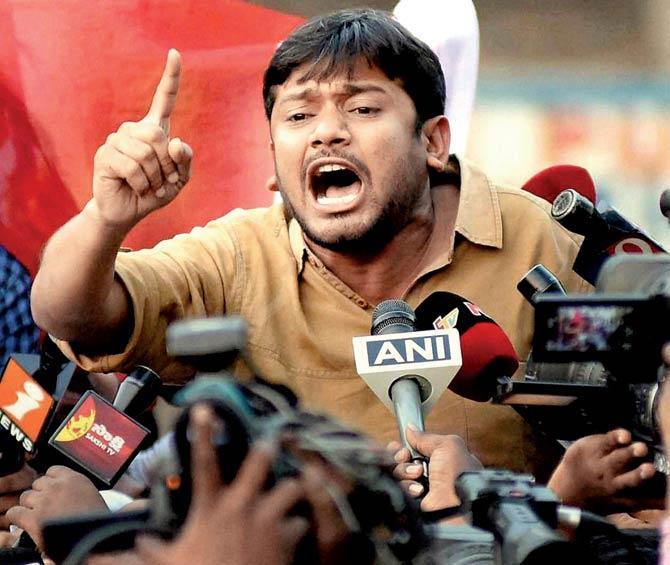Kanhaiya Kumar must understand the uses of violence for political and other forces before making his statements

 Kanhaiya Kumar, a PhD student at Jawaharlal Nehru University, is now asked to speak at the drop of a hat all over the country. Ever since, that is, he was made into a hero by the BJP-led government at the Centre for his allegedly “anti-national” comments, for which there is no evidence. That is, he was arrested for no reason. He was beaten up by pro-BJP lawyers in a courthouse in Delhi. And he has now become the posterboy for the resistance to the BJP’s absurd quarrel about nationalism and anti-nationalists.
Kanhaiya Kumar, a PhD student at Jawaharlal Nehru University, is now asked to speak at the drop of a hat all over the country. Ever since, that is, he was made into a hero by the BJP-led government at the Centre for his allegedly “anti-national” comments, for which there is no evidence. That is, he was arrested for no reason. He was beaten up by pro-BJP lawyers in a courthouse in Delhi. And he has now become the posterboy for the resistance to the BJP’s absurd quarrel about nationalism and anti-nationalists.

Kumar had said that the 1984 anti-Sikh riots were different from the 2002 Gujarat riots because the first was mob frenzy and the second was state-sponsored. Pic/PTI
ADVERTISEMENT
Having made Kanhaiya Kumar into a public personality, he has been considered for a bright political future and he is asked to make pronouncements on just about everything. I am surprised that he has not yet been asked to captain the Indian cricket team. Of course having put this young man on this pedestal, we must now look to bring him down.
In a speech this week, Kanhaiya Kumar made an error. Now this is unforgivable in today’s India because the rest of us never ever make mistakes. We have also never paid so much attention to any one single PhD student in my living memory at least. Kumar, who is avowedly anti-BJP, said that the 1984 anti-Sikh riots were different from the 2002 Gujarat riots because the first was mob frenzy and the second was state-sponsored.
And yes, he is very wrong. The reason he is wrong, however, cannot lead us into a Hindu versus Muslim, patriot versus traitor fight as so many of our vocal politicians and commentators may think. The reason he is wrong, is that riots of such magnitude cannot take place without state complicity, if not active assistance by elements of the state. By standing by and doing nothing, the state is part of a riot.
Professor Paul Brass in his must-read Riots and Pogroms, for anybody interested in the subject, talks of societies with “institutionalised riot systems”, where various elements, often criminal, are kept at the ready by political and other forces, to be brought out when required. Virginia Van Dyke, in the same book, says of the 1984 riots: “The speed with which these riots were organised following the assassination (of Indira Gandhi by her Sikh bodyguards, words in brackets mine) leads to two inescapable conclusions: they were prearranged and preplanned and an institutionalised riot structure was already in place, a pre-existing “technology of terror”.”
It is this “technology of terror” which is visible in similar riots and pogroms across the world, where divisions in society exist. It was visible in Mumbai and other parts of India after the demolition of the Babri Masjid in 1992. And it was definitely visible in Gujarat in 2002.
But Kumar is also correct. The two riots are different. In 1984, justice did not come at all. Rajiv Gandhi, whose mother’s assassination was the immediate trigger, commented that the ground shakes when big trees fall. This comment may well be true but it was shockingly insensitive when 3,000 people of the Sikh community were being butchered by his party workers for a crime they did not commit and there was no one to protect them. The Congress party will have to carry this cross forever because no excuse can ever make up for the loss and suffering.
In Gujarat, if we have seen - for almost the first time - rioters being convicted it is not because the BJP government in Gujarat and at the Centre or because Narendra Modi who was then chief minister, have seen the importance of mercy and taking responsibility. It was only a sustained effort by activists and the media that ensured that unlike other riots in India, the justice system would have some say in these. The horror of the deaths of almost 2,000 Muslims in Gujarat may be a matter of pride for those of the Ultra Hindutva persuasion, but it remains a matter of shame for India.
Brass highlights a way to find an answer to large-scale mob violence. Rather than only try and apportion blame, he suggests, try and understand the uses of violence. And there, whether Kanhaiya Kumar is right or wrong, you can even find the answer to why Kanyhaiya was arrested and attacked in the first place.
Ranjona Banerji is a senior journalist. You can follow her on twitter @ranjona
 Subscribe today by clicking the link and stay updated with the latest news!" Click here!
Subscribe today by clicking the link and stay updated with the latest news!" Click here!







